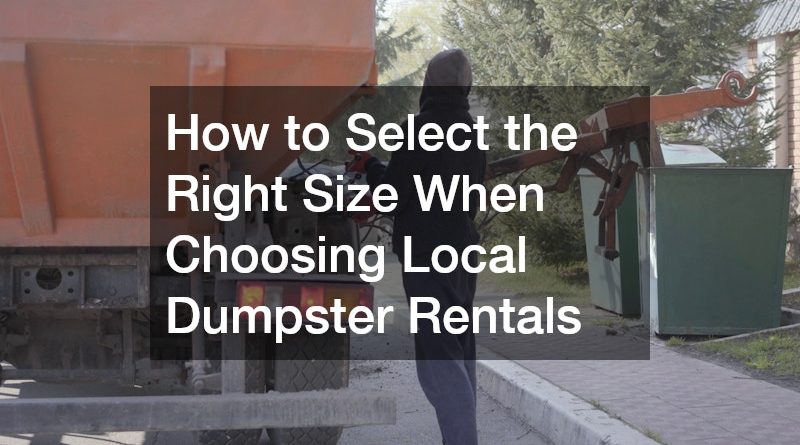How to Select the Right Size When Choosing Local Dumpster Rentals
When it comes to managing waste effectively, one of the most crucial steps is selecting the right size for your local dumpster rentals. Choosing the appropriate dumpster size can significantly impact the efficiency of your project, whether it’s a home renovation, a cleanout, or a construction job. This comprehensive guide aims to help you navigate through the various sizes available, ensuring you make an informed choice for your needs.
Learning Available Dumpster Sizes
Understanding the various sizes of dumpsters available can be a game-changer for your project. Dumpster rentals typically range from 10-yard to 40-yard sizes, each suited for different types of jobs. The smallest size, the 10-yard dumpster, is perfect for small cleanout projects or minor renovations.
On the other end of the spectrum, the large 40-yard dumpsters are well-suited for commercial projects or larger renovations. These are ideal for heavy construction debris, making them a popular choice among builders and contractors. Knowing these options helps determine what will fit your project’s needs effectively.
Additionally, many dumpster rental companies may offer specialized sizes or types designed for specific types of waste, such as yard debris or concrete. Therefore, it’s essential to check with your local rental company to understand the exact specifications they provide. This information ensures you choose the most appropriate dumpster size right from the outset.
Determining the Right Size for Your Project
Understanding how to assess your project requirements to determine the appropriate dumpster size is key to a successful project. Start by estimating the volume of waste you expect to generate, which can often be done by evaluating the scope of your project. For example, measure the area where debris will be collected and consider the types of items you are disposing of.
Another crucial factor is to take inventory of the items being discarded to clarify the overall volume. For instance, bulky items like furniture will require a larger dumpster than lighter materials like cardboard. Breaking down your project’s waste into manageable categories can give you a better idea of the total size needed.
Lastly, consider consulting with an experienced dumpster rental service. They can provide professional advice based on the specifics of your project, helping you avoid common pitfalls in size estimation. This collaborative approach ensures you have the right equipment for an efficient waste management process.
Understanding the Factors Impacting Your Choice
Several factors can influence your choice of dumpster size, including the type of waste, the duration of the rental, and the volume of debris generated. One of the primary considerations is the type of materials you plan to dispose of, as hazardous materials may require different handling and disposal methods.
The length of your project also significantly determines the size you will need. Longer projects may accumulate more waste over time, requiring an adequately sized dumpster to minimize unnecessary trips. Understanding your project timeline allows you to anticipate potential overflow and plan accordingly.
Furthermore, local regulations can play a role in determining the size of the dumpster needed. Some municipalities have specific guidelines regarding waste disposal for various types of materials that may impact what size dumpster is permissible. Ensuring compliance with local laws not only aids in a smooth project process but can also avoid additional fees.
Underestimating Dumspter Size
Seeking guidance on what to do if you find you need a larger dumpster than initially planned is crucial for understanding potential costs and logistics. Realizing you’ve underestimated your dumpster size can be stressful; however, it’s vital to handle the situation promptly. Most rental companies will allow you to upgrade to a larger size, but knowing about any potential fees is crucial.
Communicate with your dumpster rental provider as soon as you realize the need for a larger container. They will provide you with options and possibly assist in arranging a switch before your current dumpster is overloaded, thereby maintaining project continuity and preventing disruptions.
If your project timeline allows, consider postponing your rental switch to ensure that you have sufficient time for proper pickup and delivery of the new dumpster size. Planning for this contingency can save you time and money while allowing you to manage your waste disposal effectively throughout the project.
Selecting the right dumpster size is essential for efficient waste management. By considering the factors discussed in this article, such as understanding your project scope and waste volume, you can make an informed decision. This careful planning not only meets your project needs but also helps to avoid unnecessary expenses, ensuring a smoother and more economical waste disposal process.
By carefully assessing the scope of your project, the type of materials being discarded, and the available space for placement, you can make a more informed decision that supports productivity and compliance with local regulations. The right dumpster size not only streamlines waste management but also helps maintain a cleaner, safer, and more organized work environment. Thoughtful planning and consultation with your rental provider can make all the difference, ensuring you get the best value and performance for your specific project needs.

